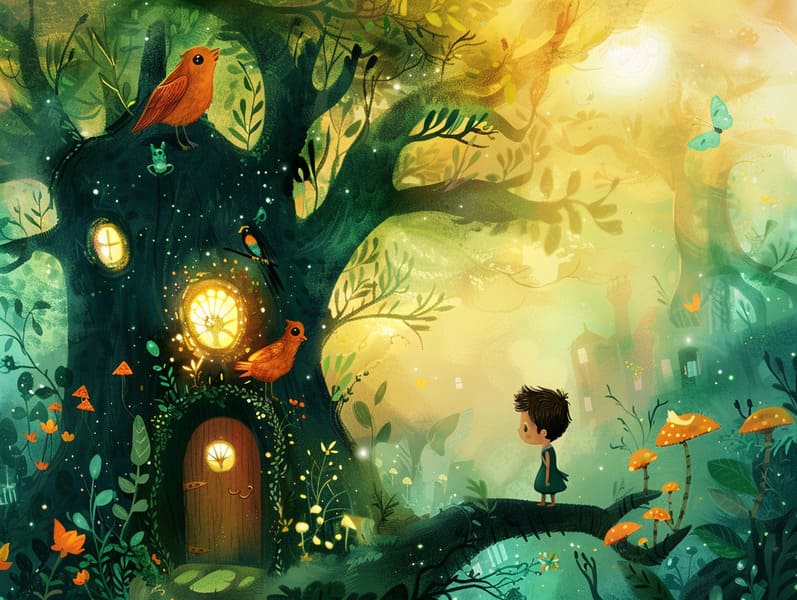The Inception of Ancient Fairy Tales and Its Immortal Mystique.
The Inception of Ancient Fairy Tales and Its Immortal Mystique.
Blog Article

Timeless fairy tales have enduring presence. These narratives have been told from one generation to the next far before they were ever written down. They emerged from a variety of civilizations, including European traditions. They were initially conveyed among elders, often carrying themes and messages relevant to the societal norms and beliefs of the time.
The Grimm brothers, Jacob and Wilhelm, were among the first to compile many of these beloved tales. Their compilation, "Grimm's Fables," included narratives like "Ashenputtel," "The Bread Crumb Trail," and "Schneewittchen," which have since become essentials in the world of children's fairy tales. Similarly, Hans Andersen's delightful stories, such as "The Little Mermaid," and "The Ugly Duckling," have floated into hearts worldwide, securing their place in the pantheon of famous fairy tales.
Despite their age, traditional fairy tales remain as pertinent as ever, especially as children's night stories. These charming stories are now available in many formats, including gorgeously illustrated books, fantastical animations, and online storybooks.
Their ongoing significance can be traced to several delightful features:
Key Lessons: Classic fairy tales often illustrate important moral lessons. Tales like "The Tale of the Boy Who Cried Wolf" teach the significance of integrity, while "The Hare and the Tortoise" illustrate the virtues of tenacity and modesty. These tales offer little ones clear distinctions between ethical and unethical, molding their moral compass in a subtle yet important way.
Compassion and Insight: Old fairy tales frequently include heroes facing problems and hurdles, motivating audiences to feel with their struggles and cheer for their triumphs. For instance, "Beauty and Her Beast" shows us the virtue of valuing inner qualities to understand the inner spirit of a individual, developing perception and knowledge.
Cultural Recognition: Many traditional fairy tales are rooted in the cultural contexts from which they arose. Understanding these narratives can provide captivating looks into different backgrounds, building a sense of cultural respect and recognition.
Imagination and Innovation: The fanciful elements in timeless fairy tales—talking animals—awaken children’s visions. These stories guide readers to fantasy realms, inspiring imaginative dreams and a sense of marvel that persists a lifetime.
Ancient fairy tales are not only fantastical but also enlightening. They function as charming tools in strengthening various cognitive and affective skills in little ones. When ancient fairy tales are narrated, they develop speech development by presenting new terms and elaborate sentence structures. This practice also enhances hearing abilities and attention, as young readers keep up with the story, anxious to see what happens next.
Furthermore, contemplating the themes and characters of timeless fairy tales can sharpen evaluative skills and reasoning skills. Little ones learn to pinpoint patterns, expect results, and get cause and effect. These contemplations also ease the young articulate their thoughts and feelings, cultivating their emotional intelligence.
In today’s information age, the accessibility of web-based fairy tales has made these fairy tales more available than ever. Web platforms and applications feature broad selections of timeless fairy tales that can be experienced or listened on anytime, anywhere. Fairy tales spoken are particularly well-liked, sharing an charming way for young ones to savor these alluring stories. Sound books and spoken videos lead characters and settings to life, often augmented by enchanting audio effects and melodies that boost the storytelling experience.
The enduring charm of classic fairy tales lies in their ability to alter to modern times while holding onto their core values. Contemporary takes of these tales often spotlight more diverse protagonists and modern settings, making them familiar to today’s audience. However, the key lessons of spirit, goodness, and rightness remain unchanged, continuing to influence audiences of all ages.
Traditional fairy tales also offer a sense of peace and homeliness. They deliver a orderly narrative with a apparent beginning, middle, and end, often coming to a close with the resolution of conflicts and the triumph of virtue over vice. This regularity can be comforting for little ones, giving a sense of steadfastness in an shifting world.
Timeless fairy tales continue to entrance and edify new generations, maintaining their spell and pertinence in modern society. As children's bedtime stories, they allow a perfect blend of captivation and insight, promoting moral values, empathy, and creativity. The availability of online storybooks and the in demand status of fairy tales narrated affirm that these ancient fairy tales remain obtainable to new generations.
By safeguarding and circulating these fairy tales, we continue to honor the rich tapestry of storytelling and cultural heritage. Whether you are browsing a vividly illustrated book, enjoying a cyber library, or hearing an spoken story, the magic of timeless fairy tales is always within reach. These stories remind us of the immortal spell of stories and its ability to unify us across centuries and lands.
No matter if you are discovering a gorgeously illustrated book, seeing a digital library, or listening via an voice book, the fascination of timeless fairy tales is always within reach.
These stories reveal of the continued strength of fairy tales and its ability to join us across centuries and lands, weaving a spell original fairy tales for bedtime that enchants and educates alike.